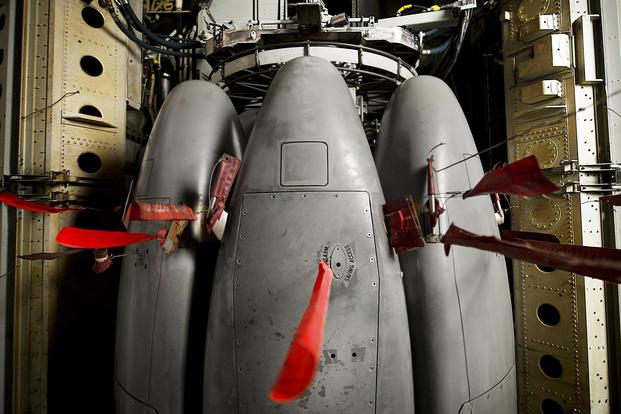Making new nuclear weapons isn't an easy task, nor is it something that can be done in just a few year's time. And while the Pentagon or months has been weighing how it plans to boost its nuclear arsenal in the future, any new bomb that will be nuclear-capable must stick to its phased development for a reason.
That includes the new Long Range Stand Off weapon, known as LRSO, which will replace the AGM-86B Air Launched Cruise Missile, known as ALCM, developed in the early 1980s, according to a top executive who oversees part of the program.
"The program of record remains 54 months, [another] 54 months, and then five years of production," said Frank St. John, executive vice president of Lockheed Martin Corp's Missiles and Fire Control.
But he added that there had been discussion about ways to speed up production if the Air Force opted to pursue that option. St. John spoke with Military.com last month in an interview detailing Lockheed's recent updates to the program.
Related content:
- US Nuclear Treaty Ultimatum about China as Much as Russia
- Nuclear Gravity Bomb Completes First Qual Tests on B-2 Bomber
- The Next B-52 Bomb Upgrade May Be a Tough Message for China
"We believe that it can go faster, but not appreciably faster," St. John said.
At most, the development phase can be cut down by a few months, he said. He added that the Pentagon hasn't approached the defense company to accelerate that development.
St. John explained it's not a timeline that can just be cut in half.
The U.S. Air Force last year awarded Lockheed and Raytheon Co. contracts to begin preliminary work on LRSO. The defense contractors were awarded agreements valued at $900 million apiece and lasting almost five years "to mature design concepts and prove developmental technologies," the service said at the time.
LRSO is a unique case because it's a strategic weapon, St. John said.
"We are about one year into a 54-month tech maturation phase," St John said, adding that Raytheon is also working in that timeframe.
At the end of four-and-a-half years, the Air Force will select a sole contractor to continue the final development of the program. The company that is selected will then work nearly another five years to manufacture the weapon.
That's "nine years of development," St John said. "There's a couple reasons for that: One, the pace of which the weapon can be developed is driven by the pace of which the payload can be developed."
St. John said the Department of Energy oversees the development of the warhead, and "having the weapon before you have the payload" is doesn't make sense.
"The process of certifying a new nuclear weapon and certifying platforms to carry [it] is a very intensive, challenging process. There's a lot of testing, there's a lot of simulation work that goes on," St John said.
Once a winner is chosen, a huge chunk of the follow-on work is certification.
"How do you make sure that the weapon is only ever going to do exactly what you want it to do and never have any kind of mishap? That drives the deadline and timeframe," St John said.
Furthermore, the first weapon manufactured, tested, approved and delivered has to have 100 percent reliability from the start. Unlike weapon systems that can be upgraded later on after being delivered to the services, LRSO needs to meet all the requirements from the beginning.
It's one reason why Lockheed has invested in a new space in Orlando, Florida, to mature the weapon.
"We've got about 350 engineers working on that program, so we need a large, classified space," St. John said of the facility, set to open in 2019 in southwest Orlando.
LRSO is a nuclear cruise missile launched from aircraft such as the B-52 Stratofortress, providing an air-launched capability as part of the nuclear triad.
Officials have even said LRSO is the crutch that will keep the Cold War-era bomber alive for decades to come.
"Without [LRSO], we don't have the B-52 as a viable platform," Gen. John Hyten, the head of U.S. Strategic Command, said last fall.
Hyten said the LRSO is necessary for the B-52 long-range bomber, because the B-21 Long Range Strategic Bomber -- the Pentagon's latest classified multi-billion dollar program -- can carry out only one nuclear mission at a time.
The LRSO is also planned for the B-2 Spirit before the Air Force retires the stealth bomber in 2032.
Last year, Rep. William "Mac" Thornberry, a Republican from Texas and chairman of the House Armed Services Committee, said he "would be willing to support" speeding up the fielding of LRSO or the B61-12 nuclear bomb given Russia’s disregard of the 1987 Intermediate-range Nuclear Forces Treaty, known as the INF.
"We see what the Russians are doing; they're not going to stand down out of the goodness of their heart, and so some sort of strong action is important," Thornberry said last March.
Thornberry has not made any public comments in response to President Donald Trump’s recent announcement that he plans to pull out of the INF treaty.
"Russia has not, unfortunately, honored the agreement, so we're going to terminate the agreement and we're going to pull out," Trump said Saturday at a campaign rally in Nevada.
"Until people come to their senses, we will build it up," he told reporters Monday at the White House, referring to the U.S. weapons arsenal. "It's a threat to whoever you want. And it includes China and it includes Russia and it includes anybody else that wants to play that game."
-- Oriana Pawlyk can be reached at oriana.pawlyk@military.com. Follow her on Twitter at @oriana0214.










